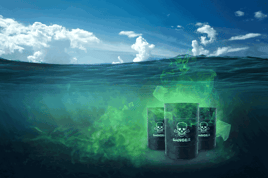
In 1976, an important motivation for enactment of the Toxic Substances Control Act (TSCA) was to empower the Environmental Protection Agency (EPA) to control polychlorinated biphenyls (PCBs), which had been developed as superlative insulation fluids but had come to be recognized as persistent toxic contaminants that bioaccumulate in the environment. TSCA banned the manufacturing, processing and distribution of new PCBs effective January 1, 1978, except in a “totally enclosed manner” or with an express exemption from EPA (including a finding that the exempt activity does not pose an “unreasonable risk of injury to health or the environment”). Even enclosed activities were banned beginning in 1979, unless with an express exemption from EPA. Additional provisions apply to non-banned activities, and to the cleanup and disposal of PCB-containing wastes. PCBs remain in use in enclosed/exempt locations throughout the country, and new contamination is identified from new leaks and legacy sites.
EPA issued most of its initial PCB rules in 1979, and has revised them from time to time over the ensuing 40 years. On October 22, 2021 EPA proposed extensive technical revisions to PCB cleanup and disposal regulations, for which I provide context and summaries in the remainder of this note.
What revisions is EPA proposing?
EPA’s stated purpose is to facilitate cleanups by easing some restrictions and introducing new options, applying recent advances in science and analytical methods and responding to ongoing requests from regulated entities.
-
Changes to permissible methods for extraction from solid matrices
EPA presently allows only two methods for extraction from solid materials (matrices), both of which are referenced in the agency’s “Test Methods for Evaluating Solid Waste: Physical/Chemical Methods Compendium” (SW-846, usually used for hazardous waste assessments under the Resource and Conservation Act (RCRA)) – Soxhlet Extraction and Ultrasonic Extraction. EPA proposes to remove Ultrasonic Extraction and add Automated Soxhlet Extraction, Pressurized Fluid Extraction, and Microwave Extraction.
-
Adding methods for extraction from aqueous matrices
EPA is proposing to add methods for liquid materials, referencing SW-846 and the agency’s “Clean Water Act (CWA) Methods” manual: Separatory Funnel Liquid-Liquid Extraction, Continuous Liquid-Liquid Extraction, and Solid-Phase Extraction.
-
Adding determinative methods
EPA presently authorizes one determinative method using gas chromatography: PCBs by Gas Chromatography. EPA proposes to add three more: an alternative PCBs By Gas Chromatography; Semivolatile Organic Compounds (PAHs And PCBs) In Soils/Sludges AndSolid Wastes Using Thermal Extraction/Gas Chromatography/MassSpectrometry; and Chlorinated Biphenyl Congeners in Water, Soil, Sediment, Biosolids, and Tissue by HRGC/HRMS.
-
Amending the performance-based disposal option (under 40 CFR 761.61(b)).
EPA provides options for disposal of PCB-contaminated waste, including performance-based options that incorporate standards for treatment, incineration, etc. EPA proposes to amend this option to provide additional referenced standards, and to add the option to use RCRA-permitted landfills for non-liquid PCB wastes.
-
Remove option for disposal as roadbed
EPA proposes to eliminate the option to dispose of PCB bulk product wastes under asphalt as roadbed.
-
Add options in emergency situations
EPA’s regulations provide flexibility for response to spills. EPA proposes to add provisions for “emergency situations,” which are newly-defined as “ … adverse conditions caused by manmade or natural incidents that threaten lives, property, or public health and safety; [and] require prompt responsive action….”, including an opportunity to apply to EPA for waiver of cleanup standards in emergency responses.
-
Additional clarifications and corrections
EPA also proposes to make several technical amendments to clarify existing standards or correct erroneous language in the rules.
What now?
Comments on the proposed revisions are due by December 21, 2021. After that, EPA will move to finalize its changes. EPA estimates that the changes to testing and determination standards would apply directly to 22 certified laboratories that provide 65,000 tests annually for customers, and that the remediation and emergency standard changes would affect approximately 400 incidents per year.
Self-evaluation checklist
Does the organization operate equipment that includes low concentrations (50 ppm or less) of PCBs
- If so, does the organization monitor the equipment to prevent and respond to leaks and spills?
Does the organization conduct any operations at locations that may have PCB contamination?
If so, does the organization make provision for testing and appropriate remediation of PCB-contaminated materials?
Where can I go for more information?
- EPA
- “Polychlorinated Biphenyls (PCBs)” homepage
- latest proposal (10/22/21 Federal Register)
About the Author
 Jon Elliott is President of Touchstone Environmental and has been a major contributor to STP’s product range for over 30 years.
Jon Elliott is President of Touchstone Environmental and has been a major contributor to STP’s product range for over 30 years.
Mr. Elliott has a diverse educational background. In addition to his Juris Doctor (University of California, Boalt Hall School of Law, 1981), he holds a Master of Public Policy (Goldman School of Public Policy [GSPP], UC Berkeley, 1980), and a Bachelor of Science in Mechanical Engineering (Princeton University, 1977).
Mr. Elliott is active in professional and community organizations. In addition, he is a past chairman of the Board of Directors of the GSPP Alumni Association, and past member of the Executive Committee of the State Bar of California's Environmental Law Section (including past chair of its Legislative Committee).
You may contact Mr. Elliott directly at: tei@ix.netcom.com

